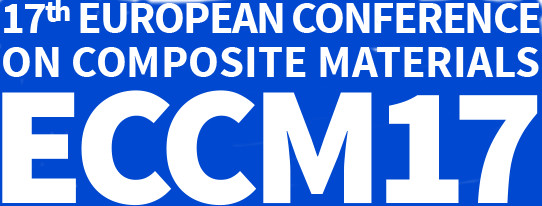

App-Einstellungen:
ENABLING LARGE STRETCHABILITY IN ASSEMBLIES OF NANOCARBONS THROUGH PRESTRESSING
Tsu-Wei Chou (University of Delaware) Jiali Yu (University of Delaware)
CNT fibers, graphene laminates, and CNT films are used to form stretchable composites which exhibit excellent flexibility and stretchability and showed stable electrical and electrochemical performances during repeated stretching cycles.
USE OF FRICTION MECHANISM FOR PSEUDO DUCTILITY IN COMPOSITES
Omar Bacarreza (Imperial College London) Raul Munoz (Imperial College London) Paul Robinson (Imperial College London) Milo Shaffer (Imperial College London)
A novel method of introducing pseudo-ductility in brittle materials by means of friction mechanisms has been investigated. Tensile behaviour of the selected configuration indicates that the ductile behaviour can be achieved.
HYBRID EFFECT OF CARBON/GLASS COMPOSITES AS A FUNCTION OF THE STRENGTH DISTRIBUTION OF ALIGNED SHORT CARBON FIBRES
HaNa Yu (University of Bristol) Marco Luigi Longana (University of Bristol) Yentl Swolfs (KU Leuven) Michael Wisnom (University of Bristol) Kevin Potter (University of Bristol)
The effect of the strength distribution of aligned discontinuous carbon layers on the enhancement in strain at failure in interlaminated carbon/glass hybrid composites was investigated experimentally, and compared with an analytical model.
HYBRID UHMWPE/CARBON MICROBRAIDS FOR DUCTILE COMPOSITES
Stefano Del Rosso (Imperial College London) Lorenzo Iannucci (Imperial College London) Paul Curtis (Defence Science and Technology Laboratory) Paul Robinson (Imperial College London)
This paper presents a comprehensive series of mechanical tests performed on core-filled hybrid microbraids and composites manufactured using those microbraids as the reinforcing phase.
TAKING ADVANTAGE OF THE HYBRID EFFECT IN THIN-PLY PSEUDO-DUCTILE LAMINATES
Michael Wisnom (University of Bristol) Gergely Czel (University of Bristol) Jonathan Fuller (University of Bristol) Meisam Jalalvand (University of Bristol)
Hybrid laminates and angle-ply laminates with thin unidirectional carbon plies have been shown to give a pseudo-ductile response with more gradual failure. This paper shows the effect of ply thickness on the initial tensile failure strain.
MECHANICAL BEHAVIOR OF ANGLE-PLY LAMINATES
Ulrich Mandel (Technical University of Munich / Institute for Carbon Composites) Robin Taubert (Technical University of Munich / Institute for Carbon Composites) Roland Hinterhölzl (Technical University of Munich / Institute for Carbon Composites)
A mechanism based nonlinear constitutive model for composite laminates is proposed. For validation, experimental results of angle-ply tension tests with varying of axis-angles and ply thicknesses are presented.
OPEN-HOLE RESPONSE OF PSEUDO-DUCTILE THIN-PLY ANGLE-PLY LAMINATES
Xun Wu (University of Bristol) Jonathan Fuller (University of Bristol) Michael Wisnom (University of Bristol)
This paper presents the response of pseudo-ductile thin-ply angle-ply laminates under open-hole tensile loading. The reduction of notch sensitivity within these laminates is also discussed.
PSEUDO DUCTILITY IN UD CFRP THROUGH INTERLAMINAR AND PLY WEAKENING
Jingjing Sun (Imperial College London) Omar Bacarreza (Imperial College London) Paul Robinson (Imperial College London)
This paper describes a study examining the behaviour of laminates containing continuous ply cuts. A simple analytical model has been used to predict the tensile response of these pre-weakened laminates.
HYDROGEL STATE IMPREGNATION OF CELLULOSE FIBRE-PHENOL COMPOSITES: EFFECTS OF FIBRE SIZE DISTRIBUTION
Yvonne Aitomäki (Lulea University of Technology) Mikael Westin (Lulea University of Technology) Kristiina Oksman (Lulea University of Technology)
Cellulose nanofibres networks produce films that have high stiffness and strength but are difficult to impregnate. Good impregnation is found if the CNF networks are impregnated in a hydrogel state.
BONDED HARD-PATCH COMPOSITE SCARF REPAIRS: INFLUENCE OF MACHINING TECHNIQUES AND SURFACE TREATMENT
Paul Wales (University of Limerick) Cormac O Brien (NUI Galway) Alan Conneely (NUI Galway) Gerard O Connor (NUI Galway) Kali Katnam (University of Manchester) Robert Young (University of Manchester)
Hard patch CFRP scarf repairs were investigated for understanding the influence of machining techniques of surfaces to be bonded on structural repair efficiency. Manual sanding, manual sanding after CNC machining and laser ablation were examined.
